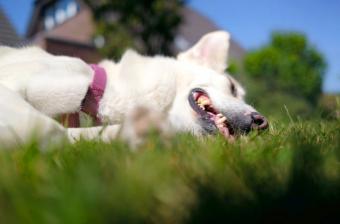
Dogs are well-known to mask any signs of pain, which is a good instinct for survival in the wild, but not so good for dog owners who want to maintain their dog's quality of life. Take comfort in knowing that if you have a strong grasp of your dog's normal behavior and a keen eye for specific behaviors, you'll be able to see minor signs of discomfort and respond properly.
Subtle Symptoms of Pain in Dogs
Learning to hide signs of illness, disease, and discomfort in the wild helps them avoid being seen as weaker or as an easy target for predators. If you pay close attention to your dog on a regular basis, you will notice physical and behavioral changes if they are in pain or experiencing discomfort. There are a number of symptoms to look out for, and if you fully understand your dog's normal behavior, these will be easier to spot.
Excessive Vocalization
Even if they're attempting to mask the pain, dogs who are experiencing discomfort tend to be more vocal, but it's not always simple to identify. Pay close attention to your dog's vocalizations when they are running, going up the stairs, or even while they're sleeping. Whimpering, whining, yelping, growling, snarling, and even howling are all vocal expressions dogs make when they are in pain. If you're noticing more vocalization than normal, this may be an indication your dog should visit the veterinarian.
Grooming or Excessive Licking
In an attempt to soothe themselves, dogs in distress frequently lick their paws or other areas of their body. When a dog gets injured, one of their initial instincts is to lick the wound to clean and care for it. This is obvious if the wound is visible, such as a cut, but even when the pain is internal, dogs will lick the affected area in an attempt to alleviate the pain and clean their wound.

Trouble Sleeping or Restlessness
It can be tough for your dog to sit or even lie down if they are in pain. That's why it's important to pay close attention even when they're sleeping. If you notice your dog sleeping in an abnormal position or sitting awkwardly, this may be a sign to see a veterinarian. You can try petting them to see if there are any areas more tender than others, but be careful as dogs in pain tend to become aggressive, just as people often do when they're not feeling well. Dogs in pain may also get up and lie down more frequently in an effort to find a more comfortable position.
As time passes, whether due to lack of sleep or increased levels of pain, your dog may exhibit extreme weakness and lethargy. You may notice your dog no longer attempting to find a comfortable sleeping position, or getting up and down due to restlessness. At this point, your dog is completely exhausted and may no longer have any interest in the joys of life they once had. They may not feel up to playing, going for a walk, playing fetch, or doing any of the other activities they normally love.
Aggressive Tendencies
When people aren't feeling well, they may be irritable, angry, and snap at others, even though they don't mean to. Dogs are similar in this sense. Dogs in pain may become aggressive suddenly, but it's important not to take this behavior personally. When your dog isn't feeling well, they may growl, snap, lunge, or even bite. That's why it's so important to take caution when feeling for tender areas. If you are at all suspicious that your dog may nip or bite, it's best to consult with your veterinarian. The veterinarian will assess the situation and determine the best way to proceed.

Reduced Interested in Food
In dogs, a change in appetite might indicate a variety of medical issues. It could also indicate that your dog is in pain. When dogs aren't interested in their food, or leave most of the food in their bowl, this may mean there is a problem. A lack of appetite, or inappetence, can indicate pain or discomfort. If your dog has never skipped a meal, you should be concerned about them refusing to eat or accept treats. Before you panic, if your dog's main symptom is skipping meals, make sure their food is the same that they are normally happy to eat and give them a food test. Try offering them a tasty food you know they love, like unseasoned, grilled chicken. If they refuse this, there is likely a problem. If their appetite doesn't return within a day or two, give the vet a call.
Heavy Panting
It's common for dogs to pant profusely during and after exercise. However, panting after activity may suggest a medical emergency, such as pain, heatstroke, or poisoning. Heavy panting without any type of exertion is definitely something worth looking into. Panting is a subtle, often overlooked indicator of pain. Dog owners are so accustomed to seeing their dogs pant, it doesn't typically register as a sign of distress. Some dogs in pain will only pant, though their appetite may remain and they may appear to be healthy and happy in other ways. If your dog is panting excessively, beyond their normal amount -- especially without activity -- it's time to call the vet.
No Desire for Affection
If your dog is normally extremely affectionate and suddenly appears to be withdrawn, this could be an indicator of pain. It's important not to panic immediately as dogs can have off days similar to humans. If your dog appears to be withdrawn for more than a day or two, this could be an indication something is happening.

Trembling or Shivering
A variety of illnesses, such as kidney disease, arthritis, distemper, or physical trauma, can cause trembling in dogs. Other symptoms, such as diarrhea, vomiting, limping, or stiffness while walking, are frequently present if there is pain involved. Temperature changes or a fear of thunder or loud noises like fireworks might trigger trembling or shivering, so keep those in mind if your dog begins trembling. Has there been any loud noises? Was there a thunderstorm today? Is it colder than normal?
If the answer to those questions is no, then this could be an indication of pain or illness. If your dog continues trembling or shaking for several hours, and any of the other symptoms discussed are noticed, taking note of them and giving the vet a call is a good idea.
Accidents in the House
Some dogs may start to have accidents in the house if they're in pain. This is completely involuntary on their part and can be from the stress and anxiety, in addition to their pain, making it harder for them to control their bladder. It's important not to punish or scold for this behavior, even though it may be frustrating. A dog in pain can't tell you how they're feeling, and if they are house-trained, this should be taken as an indication something is wrong.
Obvious Signs of Pain
While you may be looking for more subtle indications your dog is hurting, remember to not overlook obvious signs that may occur alongside other behavioral changes. Limping, bruising, yelping uncontrollably, and indications your dog has been cut or is bleeding, all indicate a larger problem. Sometimes, a dog will favor one leg, or appear to be guarding a certain area of their body. These symptoms are almost always a sign they are in pain. Often, a dog will limp for a short time and go back to moving around without an issue, or otherwise appear to return to normal, but be sure to keep an eye on them to ensure they aren't just being stoic, hiding their injury.
When to Seek Help From Your Veterinarian
Contacting your veterinarian is always the safest course of action when you notice unusual behavior from your dog. With some signs of pain, it may only be temporary and go away after a few hours or a day, such as the canine equivalent of stubbing a toe that's sensitive for a while. However, some types of pain may seem minor and can actually be a symptom of a serious medical condition that needs immediate treatment. The best thing to do is to call your veterinary clinic and discuss your dog's condition with the staff. They can advise you on whether to wait and observe your dog, or get them into the clinic right way.
What Can I Do Until We Get to the Vet?
While waiting for your vet appointment, continue to observe your dog and control their pain as best as possible. Keeping your dog comfortable and calm is an important first step to take.
Minimize Activity
If your dog shows signs of pain while participating in an activity, stop doing it until you can speak with your veterinarian. Your veterinarian will be able to advise you on how to best help your dog, whether that means completely ceasing the activity or making changes to reduce pain.
Fewer walks, the use of a ramp or steps, rolling or tossing the ball shorter distances, and lifting food and water dishes to a more comfortable height are all simple pain-relieving adaptations to everyday activities. These alterations may be temporary in some cases of acute pain, but they may become a permanent part of life if your dog is living with chronic pain problems.
Keep a Record of Your Dog's Experiences
It's not uncommon to see pain at home, but then completely blank about what to say once you reach the vet's office. That's why it's important to keep a record of the differences you are seeing, any unusual moments, and anything you want the vet to know once you reach the office.
Keep records in the form of notes, take photos, and record a short video of your dog's abnormal behavior. Be sure to write about what your dog was doing when the incident occurred. This can be extremely helpful to your veterinarian and can assist in determining the appropriate course of action.
Over-the-Counter Medications
Steer clear of medications such as Ibuprofen and Tylenol, as these can do more harm than good. Aspirin is a medication you can try to help ease the pain until you get to the vet. The recommended dosage is 5 mg to 10 mg of aspirin per pound of a dog's weight, given once every 12 hours, as directed by your veterinarian. Be certain to speak to your veterinarian prior to providing the medication, though. Mention to your vet that you think your dog may be in pain. This will allow them to review your dog's history to ensure it's safe to give the medication.
Holistic Remedies
There are some holistic remedies for those who would rather not provide pharmaceutical-type medications to their dog. If you would rather have a natural approach to pain relief, consulting with a holistic veterinarian could prove beneficial to you. Before your appointment, to ease the pain, they may recommend arnica montana administered either topically or orally, or white willow bark for minor aches and pain relief.
Knowing the Signs of Pain in Dogs
Every dog is different, and like people, will handle pain in their own way. A responsible, well-educated, observant dog owner will be able to notice when things just don't seem right, such as when a happy dog suddenly withdraws from contact, exhibits signs of aggression, or refuses to eat. Dogs can experience pain from serious illnesses such as cancer and kidney disease, joint disorders such as hip dysplasia and arthritis, from physical injuries, and from changes in their bodies as they reach old age. Fully understanding your dog and their daily routine can help prevent them from experiencing long-term pain by getting them veterinary assistance sooner rather than later.







